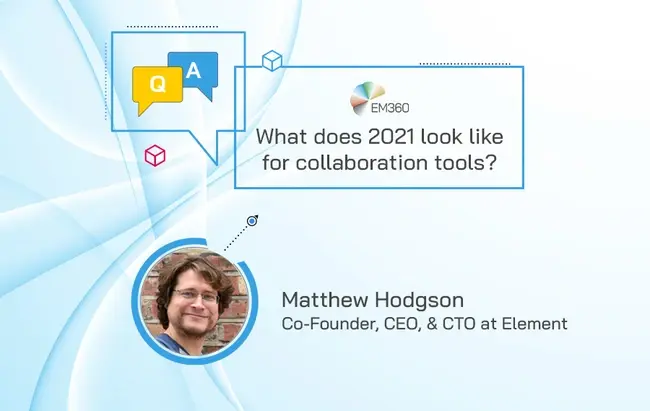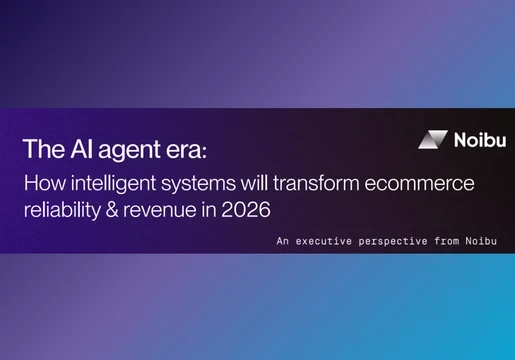2020 has been the year for collaboration tools. As countries plunged into lockdown, collaboration tools came to the rescue, keeping our businesses running and our employees connected.
While yes, there were some teething problems (if I had a pound for every “you’re on mute”...) and some controversies (cough, Zoom, cough), collaboration tools have been at the heart of business continuity.
It comes as no surprise then that revenue and shares of collaboration offerings soared this year – but what kind of stage does that set for these tools in 2021 and where do they fit into a post-pandemic world?
To find out more about what the future holds for collaboration tools, we spoke to Matthew Hodgson, co-founder, CEO, and CTO at Element, a secure collaboration platform.

Thanks for joining us, Matthew! Firstly, could you tell us a little bit about yourself and Element?
Thank you for speaking with me. I am the co-founder and CEO of Element. I’ve been working on communication solutions since the early 2000s, and I am also the technical co-founder of Matrix, the open-source, decentralised network on which Element is based.
Element is a new type of messaging and collaboration app which allows organisations to keep control and ownership of their data. Users are able to choose where their data resides - on a cloud service provider of their choice, or even their own on-premise hardware - rather than being beholden to a centralised service provider. This gives the user full control and ownership of their data.
By taking advantage of the open Matrix network, Element makes it easy for people to collaborate with anyone they need to - internally or externally. It’s as simple to use as email. Element is also secure by design, taking a zero-trust approach by decentralising conversations over untrusted servers, with end-to-end encryption (E2EE) and cross-signed verification.
Element is at the heart of the world’s largest messaging and collaboration deployments; supporting 500K users across public offices and education throughout Schleswig-Holstein and Hamburg, the French government’s Tchap system and Germany’s Bundeswehr.
Obviously given the nature of Element’s offering, you’ve been at the heart of the collaboration tool boom! What’s this year been like for you guys?
This year has been incredibly busy for Element. We’ve grown considerably, and we see that continuing for three reasons.
First, organisations are moving away from consumer-grade messaging solutions such as WhatsApp. They were regarded as ‘good enough’ at the start of the pandemic, but no organisation is going to allow its employees to remain discussing work matters on apps from companies whose business model is based on data mining. By enabling organisations to choose how and where to host their messaging and collaboration, Element delivers data sovereignty which is crucial for governments and other organisations that have to take security seriously.
Second, the marketplace is realising that traditional collaboration tools, such as Slack and Microsoft Teams, are not end-to-end encrypted. Given the widespread use and adoption of collaboration tools to support remote working, end-to-end encryption is a must have for any organisation that’s security-centric.
The third driver is the open network. The only reason email still exists is that most real time communication is closed off in proprietary walled gardens. Element - and the open Matrix network - supports collaboration between people across multiple organisations without any additional costs. As a result, you see genuine network effects forming - as more enterprises come on board Matrix, the more useful the network becomes; in fact, according to Metcalfe’s Law the value of the network increases with the square of the number of connected users!
Outside of our growth, 2020 saw us enable end-to-end encryption by default - which is a huge feat given we’re operating across a decentralised environment. We also launched a brand new Android app and released hundreds of other features and improvements across Mobile and Desktop.
For organisations that want Element (or indeed any Matrix-based system) as a hosted service, we’ve made huge strides in developing Element Matrix Services. Organisations are now able to simply spin up a dedicated Matrix-hosting environment for super-fast deployment and hassle-free best practice management.
We also completed our first acquisition, purchasing Gitter from GitLab, which is the only chat platform focused exclusively on developers. Gitter has been fully integrated within two months of the acquisition, and now natively speaks Matrix, connecting all its users and rooms into Matrix and vice versa.
How have collaboration tools or the way that we use them changed this year?
This year collaboration tools and the way we use them have changed significantly. The emergence of modern workplace technology has enabled people to work together while being apart. The working world has adapted to these unprecedented circumstances, and organisations were quick to get their workforces online to keep their businesses running efficiently and productively.
Now organisations use a variety of video conferencing systems, collaboration tools and messaging apps every day. However, most free messaging and collaboration apps do not stand up to business-level scrutiny. Organisations are faced with an unmanaged mix of traditional, out-of-date collaboration tools and consumer-grade messaging apps. Not only does this leave organisations data strewn across multiple platforms, but they also have little control over how the data is secured, managed and accessed. Better data privacy and security is something that the pandemic and remote working have highlighted as crucial for working in the digital era.
What do you think will be in store for collaboration tools in 2021, and where will they fit in post-pandemic?
The two most powerful trends for enterprise messaging and collaboration in 2021 will be interoperability and data sovereignty.
Given the huge range of messaging apps and collaboration tools, organisations will favour those that are interoperable. Walled gardens won’t be sustainable. Indeed we see a number of customers using Element Matrix Services as the ‘glue’ that unites their Slack-centric employees with those using other proprietary apps or alternative systems such as IRC. It’s also a way to bring messaging apps in from the realms of shadow IT. That’s why so many of our Element Matrix Services customers take advantage of bridges to integrate the likes of Slack and Telegram.
It’s also worth noting that within the EU, the new Digital Markets Act will mandate interoperability between messaging apps - preventing ‘gatekeepers’ from locking in their users. An open network, Matrix was developed to provide interoperability between communication systems so we’re really pleased to see not just consumer and business demand for interoperability, but now regulation too.
We’ll also see more organisations choose services which give them control over their data. Governments and NGOs are uncomfortable with centralised systems up their data and storing in their own proprietary systems. Governments want their data, on their servers, in their country.
Do you think remote working is here to stay even after the pandemic ends?
The pandemic has fast-forwarded the adoption of remote and hybrid working by five, maybe even 10, years. It’s here to stay, and will continue to evolve. There will be widespread use of messaging and collaboration, both within individual organisations and across entire supply chains.
Real time communication enables far more flexible working styles. It helps organisations be more productive and more ecologically-minded. It reduces the need for office space, business travel, and can aid the war for talent by offering employees a better work-life balance.
Real time communication is faster and richer than email and more secure. Operating over an open network, with interoperability based on open standards, it’s just as universal and as simple to use.







Comments ( 0 )